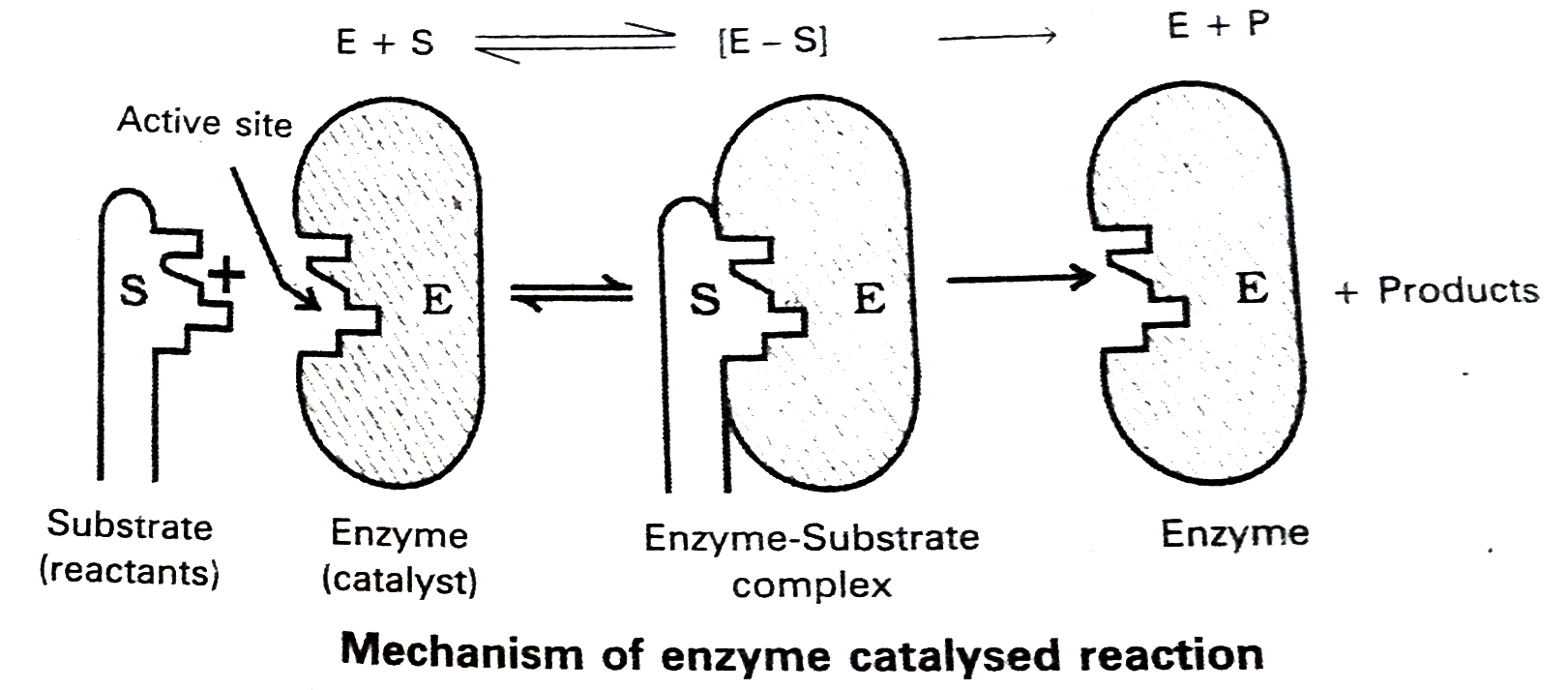What are enzymes ? Give examples ? Solution in Telugu
Enzymes are complex nitrogenous organic compound which are produced by living plants and animals.
→ These act as specific catalysts in biological reactions.
→ These catslyse the numerous reactions that occur in the bodies of animals of animals and plants to maintain the life process.
Mechanism of enzyme catalysis :

The enzyme - catalysed reactions may be considered to proceed in two steps.
Step 1 : Binding of substrate to enzyme to form an activated complex (ES≠).
E+S→ES≠
Step 2 : Decomposition of the activated complex to form product.
ES≠→E+P
Factors influencing the catalystic activity of enzymes
→ Highly specific nature : One catalyst catalyses only one reaction. Each enzyme is specific for a given reaction.
Eg : The enzyme urease catalyses the hydrolysis of urea only and not any other amide
→ Highly active under optinum temperature: The rate of an enzyme reaction is maximum at a temperature called optimum temperature.
The optimum temperature range for enzymatic activity is 298 - 310 K.
→ Highly active under optimum pH : The rate of an enzyme - catalysed reaction is maximum at a particular pH called optimum pH which lies between 5 - 7
→ Increasing activity in presence of activators and co-enzymes : The enzymatic activity is increased in presence of co-enzymes (or) in presence of activators such as Na+,Mn+2 etc.,
Influence of inhibitors and poisons : The inhibitors (or) poisons interact with the active functional groups on the enzyme surface and reduce or completely destroy the catalytic activity.
i) Inversion of Cane sugar : Enzyme : Invertase
C12H22O11(aq)Cane sugar+H2O(l)Invertase−−−−→C6H12O6(aq)+C6H12O6(aq)FructoseGlucose
ii) Conversion of glucose into Enthyl alcohol : Enzyme : Zymase
C6H5O6(aq)GlucoseZymase−−−→2C2H5OH(aq)Ethyl alcohol +2CO2(aq)
Conversion of starch into maltose : Enzyme : Diastase
2(C6H10O5)n(aq)Starch+nH2O(l)Diastase−−−−→2C6H12O11(aq)Maltose
iv) Conversion of maltose into glucose : Enyzme : Maltose
C12H22O11(aq)Maltose+H2O(l)Urease−−−→2NH3(g)+CO2(g)
v) Decomposition of urea into ammonia : Enzyme : Urease
NH2CONH2(aq)+H2OUrease−−−→2NH2(g)+CO2(g)
vi) Conversion of milk to curd : Enzyme : Lacto bacilli
Milk lacto bacilli−−−−−−→ Curd.
Topper's Solved these Questions
- SURFACE CHEMISTRYBOOK - VIKRAM PUBLICATION ( ANDHRA PUBLICATION)CHAPTER - SURFACE CHEMISTRYEXERCISE - INTEXT QUESTIONS
8 Videos
- SURFACE CHEMISTRYBOOK - VIKRAM PUBLICATION ( ANDHRA PUBLICATION)CHAPTER - SURFACE CHEMISTRYEXERCISE - SHORT ANSWER QUESTIONS
50 Videos
- SOLUTIONS BOOK - VIKRAM PUBLICATION ( ANDHRA PUBLICATION)CHAPTER - SOLUTIONS EXERCISE - INTEXT QUESTIONS
10 Videos
- TELANGANA MARCH-2019BOOK - VIKRAM PUBLICATION ( ANDHRA PUBLICATION)CHAPTER - TELANGANA MARCH-2019EXERCISE - SECTION C
6 Videos
Similar Questions
Write any two characteristics of Chemisorption.
View SolutionWhat is adsorption ? Discuss the mechanism of adsorption of gases on solids.
View SolutionCalculate the mole fraction of benzene is solution containing 30% by mass in carbon tetrachloride.
Then calculate the mole fraction by using the formula
Mole fraction of a component =Number of moles of the componentTotal number of moles of all components
xA=nAnA+nB
View SolutionHow is chlorine prepared by Deacon's process ? Explain its reactions with Hot Conc. NaOH, H2SandNa2S2O3.
View SolutionWhat are enzymes ? Give two example with uses.
View Solutionएंजाइम उत्प्रेरक क्या है? इसके दो प्रमुख उदहारण दीजिये!
View Solutionएन्जाइमस क्या होते है ? कुछ उदाहरण दीजिए ।
View SolutionWhat are enzymes ? Give examples ?
View Solutionको-एन्जाइम किसे कहते हैं? एक उदाहरण दीजिए।
View Solutionको-एन्जाइम किसे कहते हैं? एक उदाहरण दीजिए।
View SolutionGive examples.
Digestive enzymes
View Solutionको-एंजाइम क्या है? एक उदाहरण दीजिए।
View SolutionWhat is an enzyme activator? Give an example of an enzyme catalyst.
View Solutionঅ্যামাইলোলাইটিক উৎসেচক কাকে বলে? উদাহারণ দাও।
View SolutionWhat is a proteolytic enzyme? Give an example.
View Solutionলাইপোলাইটিক উৎসেচক কাকে বলে? ঊদাহারণ দাও।
View Solution
